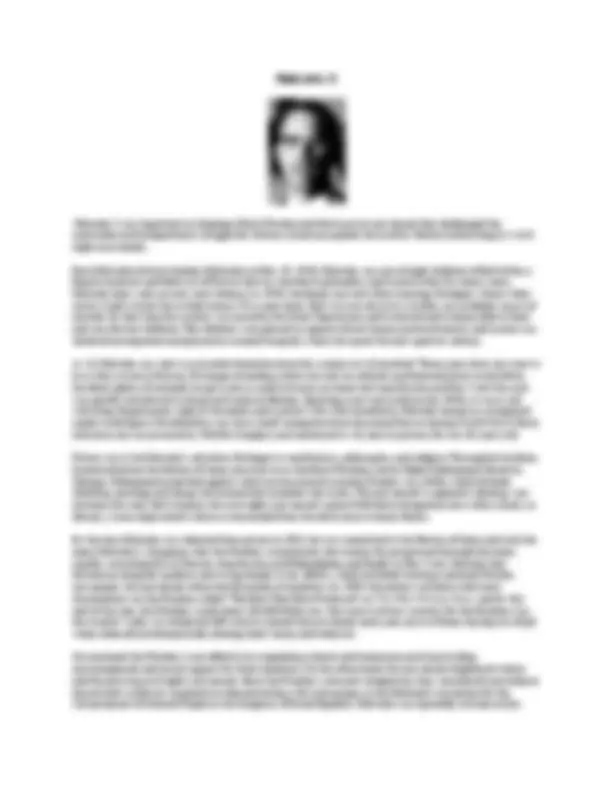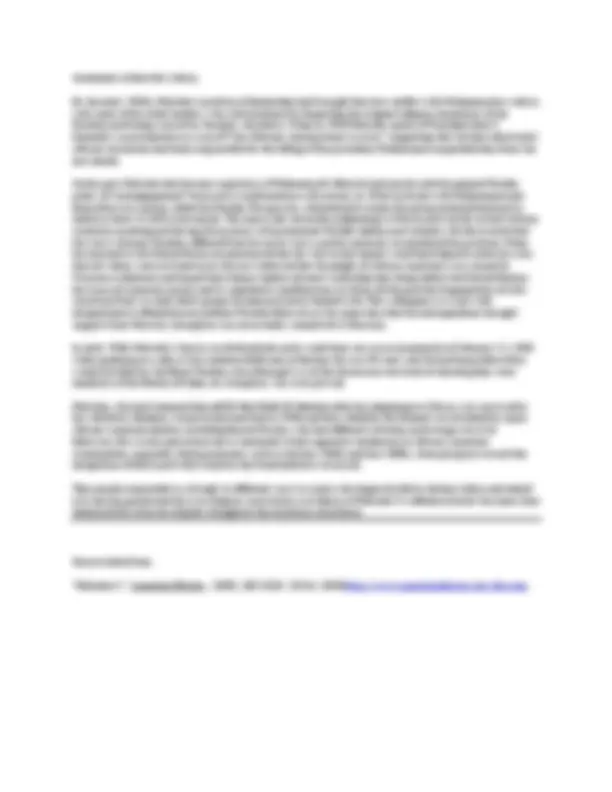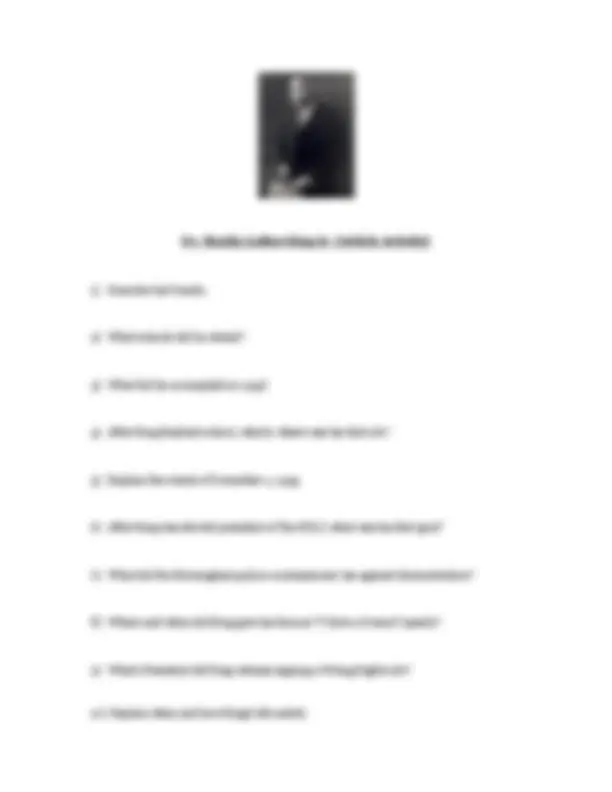





Study with the several resources on Docsity

Earn points by helping other students or get them with a premium plan


Prepare for your exams
Study with the several resources on Docsity

Earn points to download
Earn points by helping other students or get them with a premium plan
Community
Ask the community for help and clear up your study doubts
Discover the best universities in your country according to Docsity users
Free resources
Download our free guides on studying techniques, anxiety management strategies, and thesis advice from Docsity tutors
A detailed comparison of the lives, beliefs, and contributions of two prominent figures in the American Civil Rights Movement, Martin Luther King, Jr. and Malcolm X. It includes information about their backgrounds, education, and involvement in the movement, as well as their differing philosophies and strategies for achieving equality for African Americans. The document also covers the final years of Malcolm X's life and his break with the Nation of Islam.
What you will learn
Typology: Schemes and Mind Maps
1 / 7

This page cannot be seen from the preview
Don't miss anything!




Martin Luther King – Biography Martin Luther King, Jr. , (January 15, 1929-April 4, 1968) was born Michael Luther King, Jr., but later had his name changed to Martin. His grandfather began the family's long tenure as pastors of the Ebenezer Baptist Church in Atlanta, serving from 1914 to 1931; his father has served from then until the present, and from 1960 until his death Martin Luther acted as co-pastor. Martin Luther attended segregated public schools in Georgia, graduating from high school at the age of fifteen; he received the B. A. degree in 1948 from Morehouse College, a distinguished Negro institution of Atlanta from which both his father and grandfather had been graduated. After three years of theological study at Crozer Theological Seminary in Pennsylvania where he was elected president of a predominantly white senior class, he was awarded the B.D. in 1951. With a fellowship won at Crozer, he enrolled in graduate studies at Boston University; completing his residence for the doctorate in 1953 and receiving the degree in 1955 In Boston he met and married Coretta Scott, a young woman of uncommon intellectual and artistic attainments. Two sons and two daughters were born into the family.
In 1954, Martin Luther King accepted the pastorate of the Dexter Avenue Baptist Church in Montgomery, Alabama. Always a strong worker for civil rights for members of his race, King was, by this time, a member of the executive committee of the National Association for the Advancement of Colored People, the leading organization of its kind in the nation. He was ready, then, early in December, 1955, to accept the leadership of the first great Negro nonviolent demonstration of contemporary times in the United States, the bus boycott described by Gunnar Jahn in his presentation speech in honor of the laureate. The boycott lasted 382 days. On December 21, 1956, after the Supreme Court of the United States had declared unconstitutional the laws requiring segregation on buses, Negroes and whites rode the buses as equals. During these days of boycott, King was arrested, his home was bombed, he was subjected to personal abuse, but at the same time he emerged as a Negro leader of the first rank.
In 1957 he was elected president of the Southern Christian Leadership Conference, an organization formed to provide new leadership for the now burgeoning civil rights movement. The ideals for this organization he took from Christianity; its operational techniques from Gandhi. In the eleven-year period between 1957 and 1968, King traveled over six million miles and spoke over twenty-five hundred times, appearing wherever there was injustice, protest, and action; and meanwhile he wrote five books as well as numerous articles. In these years, he led a massive protest in Birmingham, Alabama, that caught the attention of the entire world, providing what he called a coalition of conscience. and inspiring his "Letter from a Birmingham Jail", a manifesto of the Negro revolution; he planned the drives in Alabama for the registration of Negroes as voters; he directed the peaceful march on Washington, D.C., of 250,000 people to whom he delivered his address, "l Have a Dream", he conferred with President John F. Kennedy and campaigned for President Lyndon B. Johnson; he was arrested upwards of twenty times and assaulted at least four times; he was awarded five honorary degrees; was named Man of the Year by Time magazine in 1963; and became not only the symbolic leader of American blacks but also a world figure.
At the age of thirty-five, Martin Luther King, Jr., was the youngest man to have received the Nobel Peace Prize. When notified of his selection, he announced that he would turn over the prize money of $54,123 to the furtherance of the civil rights movement.
On the evening of April 4, 1968, while standing on the balcony of his motel room in Memphis, Tennessee, where he was to lead a protest march in sympathy with striking garbage workers of that city, he was assassinated.
Source taken from:
From Nobel Lectures, Peace 1951-1970, Editor Frederick W. Haberman, Elsevler Publishing Company, Amsterdam, 1972 < Nobelprize.org>.
statements of hate for whites.
By the early 1960s, Malcolm's position of leadership had brought him into conflict with Muhammad as well as with some of the other leaders, who criticized him for forgetting the original religious intentions of the Muslims and being swayed by the glory of politics. When in 1963 Malcolm spoke of President John F. Kennedy's assassination as a case of "the chickens coming home to roost," suggesting that the hate directed at African Americans had been responsible for the killing of the president, Muhammad suspended him from the movement.
On his part, Malcolm had become suspicious of Muhammad's lifestyle and morals and the general Muslim policy of "nonengagement" from active confrontation with racism. In 1964, he broke with Muhammad and formed his own group, called the Muslim Mosque, Inc., determined to make the group international and to initiate a back-to-Africa movement. The same year, he made a pilgrimage to Mecca and visited several African countries, meeting and having discussions with prominent Muslim leaders and scholars. He discovered that the views of many Muslims differed from his racist views, and he seriously reconsidered his position. When he returned to the United States, he announced that his visit in the Islamic world had helped to alter his view that all whites were evil and racist. He now believed that the plight of African Americans was caused by Western civilization and hoped that Islamic leaders abroad would help him bring before the United Nations the issue of American racism and its capitalistic ramifications in Africa. He formed the Organization of Afro- American Unity to unify black groups he had previously feuded with. This willingness to work with integrationists offended more militant Muslim followers at the same time that his anticapitalism brought support from Marxists, though he was not actually committed to Marxism.
In early 1965, Malcolm's house was firebombed, and a week later, he was assassinated on February 21, 1965 while speaking at a rally at the Audubon Ballroom in Harlem. He was 39 years old. He had long believed he would be killed by the Black Muslims, but although two of the three men convicted of shooting him were members of the Nation of Islam, no conspiracy was ever proved.
Malcolm, who had renamed himself El-Hajj Malik El-Shabazz after his pilgrimage to Mecca, was survived by his wife Betty Shabazz, whom he had married in 1958, and four children. His funeral was attended by many African-American leaders, including Bayard Rustin, who had differed with him, and a huge crowd of followers. His words and actions have continued to fuel separatist tendencies in African-American communities, especially during moments, such as the late 1960s and late 1980s, when progress toward the integration of black and white America has been halted or reversed.
That people responded so strongly in different ways to a man who began his life by hating whites and ended it by having questioned his own deepest convictions is evidence of Malcolm X's influence and at the same time characteristic of an era of great struggle in the American conscience.
Source taken from:
“Malcolm X.” American History. 2008. ABC-CLIO. 30 Oct. 2008 http://www.americanhistory.sbc-clio.com.